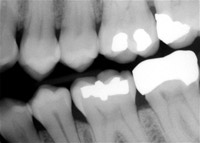 In order to provide our patients with the highest quality of dental services, we use dental radiographs, or X-rays, in our office. These radiographs provide us with invaluable information about your oral and dental health.
In order to provide our patients with the highest quality of dental services, we use dental radiographs, or X-rays, in our office. These radiographs provide us with invaluable information about your oral and dental health.
While radiographic equipment does produce radiation (and depends on that radiation to function properly), modern advances in technology are continually reducing the amount of radiation that is produced. In fact, studies have shown that the amount of radiation produced by these machines is not significantly higher than other "normal" sources of radiation that we are exposed to on perhaps a daily basis, such as televisions and airplanes.
X-rays work on a simple principle: the X-rays are stimulated and sent through the mouth. When these rays pass through, they are absorbed more by the bones in your mouth than the gums and other soft tissues, creating a picture of how the teeth inside your mouth are positioned, as well as any potential areas of weakness or decay in your teeth.
While this radiation is very low, it is still recommended that pregnant women avoid any unnecessary X-rays. However, pregnant women are also more vulnerable to gum disease, so x-rays be recommended, in which case proper precautions should be taken, such as using a lead apron and thyroid collar.